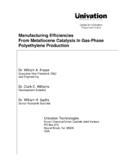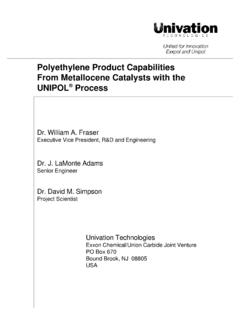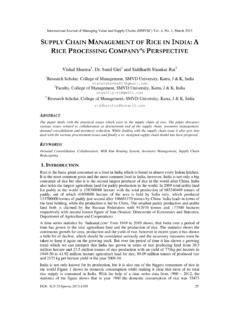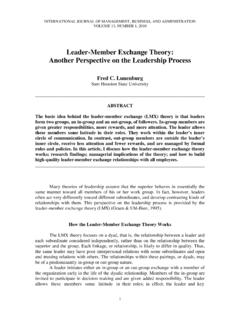Transcription of Commercial Perspective on New Developments in …
1 Commercial Perspective on New Developments in catalysis for Olefin PolymerizationWilliam A. FraserExecutive Vice President, R&D and EngineeringUNIVATION TECHNOLOGIESP resented atSPE ANTECMay 19991 Commercial Perspective ON NEW Developments IN catalysis FOR OLEFIN POLYMERIZATIONABSTRACTO lefin polymerization catalysis is a domain of major research activity. For the last decade,much of this research has been focused in the area of metallocene catalysis , which has been atthe front line in driving important technologyrenewal in the polyolefins industry.
2 Developmentsin metallocene catalysis have instigated muchtrade press discussion, and now emerging non-metallocene catalyst systems are adding newscope to the industry dialog. Announcements continue to flow in the trade press about theindustry s latest new catalyst discoveries. Hetero-substituted cyclopentadiene ligands coordinated with conventional Group IV metals;sterically-hindered, nitrogen-containing ligandscoordinated with a variety of transition metal centers, including late transition metals such asFe, Co, Ni, and Pd; and other heteroatom-basedtransition metal complexes have been shown to be activated with alumoxanes to form catalyticspecies that polymerize olefins to various types of polymers.
3 These laboratory Developments illustrate, once again, the ever-widening range ofcatalytic systems for olefin polymerization . This paper will offer some limited commercialperspective on new catalyst Developments usingthe context of possible business significance to the polyethylene industry. Since some of thesedevelopments are barely out of the laboratory, it spretty early to be writing to provide commercialperspective on these systems. The only way that I could conceive to address this subject was tooffer some insights on what has been learned fromthe ongoing development and commercializationof metallocene technology for polyethylene manufacture.
4 I would expect some of these commercialization learnings to anticipate what will be encountered with other new catalyst systems. The Commercial Perspective I hope tooffer will speak both to factors influencing the size of the Commercial prize and to challengesaffecting the timeline for reaching the marketplaceand capturing a piece of this Commercial prize. INTRODUCTIONThe family tree of ligand-based catalysts is growing. Figure 1shows a schematic of this enlarging family tree with new structures moving well beyond the metallocene domain ofcyclopentdienyl-containing systems.
5 Symmetricand assymetric structures, bridged and unbridged,chiral and achiral catalysts are represented. In allthese systems, the ligand structure, metal center,and activation chemistry define the electronic andsteric environment at the active site of the catalystand, in turn, establish the catalyst s regulation ofthe stochastic processes of monomer/comonomerinsertion (stereospecific or non-stereospecific) andvarious chain transfer chemistries. In Figure 1, metallocenes represent one verylarge, important category of ligand-based catalysis represents a very broad andvery rich technology.
6 There are an enormous number of potential catalyst systems. Some of these catalysts have progressed through theinnovation pipeline from research through development to reach the arena of full-scale product new non-metallocene, ligand-based catalyst structures outlined in Figure 1represent,for the most part, Developments that are still quitefar upstream, inside the innovation process, andare still undergoing laboratory scoping studies. The general capabilities of these new chemistries,let alone their uniquecapabilities, are not yet fullyunderstood.
7 It will be the unique performancecapabilities of these catalysts that will determinetheir Commercial significance to our Perspective ON NEW Developments IN catalysis FOR OLEFIN POLYMERIZATIONMETALLOCENE CATALYST SYSTEMS development /COMMERCIALIZATIONThe ongoing development and commercializa-tion of metallocene technology in our industry provides one practical benchmark for conjecturingabout the future Commercial significance of emerging discoveries in catalysis . The seminalresearch in metallocene catalysis dates from themid to late 1970s, with development and prototypecommercialization beginning in earnest in theearly 1990s.
8 As we end this decade, supply anddemand for metallocene-based polyethylenes havebecome commercially meaningful and show catalyst systems are now usedcommercially in the manufacture of several families of new and improved polymers for both specialty and volume PE markets. The development of these catalysts has been describedas a major milestone in the history of polyolefintechnology development . Metallocene chemistry,applied to polyethylene production, brings significant product performance enhancements and applications functionality valued in the resin marketplace as well as significant processtechnology benefits valued in the manufacturingarena of world scale PE of the major (and growing) uses of metallocene catalyst systems is the production of linear low-density polyethylene (mLLDPE)using the UNIPOL gas-phase process.
9 Productioncapacity continues to build and demand continuesto increase for these new resins. I will use some of this UNIPOL PE experience with metallocenecatalysts as a vantage point for attempting to provide Commercial Perspective on the new catalyst chemistries now emerging from NON-METALLOCENE LIGAND-BASED CATALYST SYSTEMSThe discovery of new catalyst chemistries forolefin polymerization seems to be a recurrenttopic in our industry trade press. The intensity of discussion of metallocene chemistry, its capabilities and implications for the polyolefinFIGURE 1 FAMILIES OF LIGAND-BASED SINGLE-SITE CATALYSTSM etalloceneNon-MetalloceneR = LIGAND (Cp or other);X = Standard Leaving Group(Halogen, alkoxide, etc.)
10 Current Area ofIntense ResearchRaMXbTwo C5ringsOne C5ringNo C5ringsunbridgedbridgedHetero CpNo CpChelatesisobis-Cpsyndiobis-Indotherunb ridgedbridgedbis-Cp Systemsbis-Ind otherunbridgedbridgedBidentateTridentate C-bridgedhal ligandsnon-hal ligandsSi-bridgedC-bridgedSi-bridgedCp-I ndCp-Flualkylnon-alkylN-LigandsMixed HeteroLigandsMixed HeteroLigandsN-LigandsCOMMERCIAL Perspective ON NEW Developments IN catalysis FOR OLEFIN POLYMERIZATIONFIGURE 2 NON-METALLOCENE LIGAND-BASED CATALYSTS:HETEROATOM CYCLIC COMPLEXES industry, has spawned its own cottage industry in consultant reports and conference Developments in non-metallocenecatalysis are now the subject of press releases,and in turn, becoming an added focus of punditanalysis and trade press discussion.









